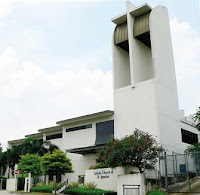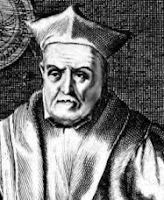 |
| Montagnais Indian winter encampment |
The party sat in silence, listening for the bells, which on the stroke of midnight began to toll. The village was aroused, and the people hurried to the chapel, and there, before the altar, lay the old Jesuit, dead. They watched by the corpse until daylight, when the post officer ordered four men to take a canoe and go to Ile-aux-Condres. A fearful storm was raging in the Gulf, and ice floes almost choked the wide expanse of water. "Fear not," said the officer to the fishermen; "Father Labrosse will protect you." They launched the canoe, and great was their surprise to find that, while the tempest howled and the waves and the ice seethed like a caldron on each side of them, a peaceful channel was formed by some invisible hand for their craft. They reached Ile-aux-Coudres — over sixty miles, as the crow flies, from Tadousac — without accident. Father Cornpain was standing on the cliff, and, as they neared the shore, he cried out,
Link (here) to The Atlantic Monthly
"Father Labrosse is dead, and you have come to take me to Tadousac to bury him!" How did he know this? The night previous he was sitting alone in his house, reading his breviary, when suddenly the bell in the church (dedicated to St. Louis) began to toll. He ran down to the church, but the doors were locked, and when he opened them he found no one within, and still the passing bell was tolling. As he approached the altar, Father Compain heard a voice saying, "Father Labrosse is dead.This bell announces his departure. "To-morrow do thou stand at the lower end of the island and await the arrival of a canoe from Tadousac. Return with it, and give him burial." And at all the mission posts where Father Labrosse had preached — Chicoutimi, I'lle Verte, Trois-Pistoles, Rirnouski, and along the Baie-des-Chaleurs — the bells, of their own accord, rang out the death of the old Jesuit at the same hour. And for many a year, whenever the Montagnais Indians of the Saguenay visited Tadousac, they made a pilgrimage to his grave, and whispered to the dead within through a hole in the slab of the vault, believing that he would lay their petitions before God.
Link (here) to The Atlantic Monthly




































